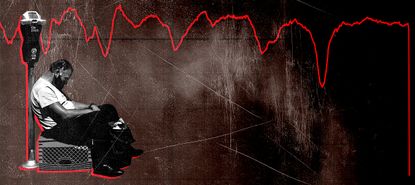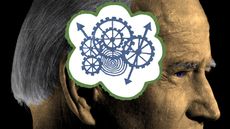Unemployment is a catastrophe — but it could still be worse
Expanded unemployment benefits are the only thing keeping millions of Americans from abject poverty


The American economy is in freefall. In April, the U.S. lost 20.5 million jobs, and the unemployment rate spiked to 14.7 percent — the highest rate since the Great Depression, by a considerable margin. Most business sectors were smashed, particularly scenic transportation, dentists, and theaters, which saw an annualized shrinkage rate of 100 percent. State and local government employment plummeted by nearly a million — worse than the worst month for the entire economy during the 2008 crash.
Now, it's not quite as bad as it looks. The point of the coronavirus lockdowns and the associated rescue packages was to put the economy in stasis, and that is basically what is happening. Most of the rise in unemployment is so far at least theoretically temporary. Without the virus, it ought to be possible to return to normal fairly quickly with another big dollop of economic stimulus.
However, that means the possibility of restoring all these jobs after the crisis passes will depend on controlling the pandemic, which is not even close to happening — on the contrary, President Trump is doing essentially nothing, and it is clear he is incapable of managing the crisis. States are already relaxing their containment measures despite cases outside the New York-area epicenter still increasing. We will need much more to keep the damage from becoming permanent.
Subscribe to The Week
Escape your echo chamber. Get the facts behind the news, plus analysis from multiple perspectives.

Sign up for The Week's Free Newsletters
From our morning news briefing to a weekly Good News Newsletter, get the best of The Week delivered directly to your inbox.
From our morning news briefing to a weekly Good News Newsletter, get the best of The Week delivered directly to your inbox.
As Matt Bruenig writes for the People's Policy Project, the various economic rescue bills pass so far have been a mixed bag. The best parts were the Payroll Protection Program, which gave out loans to small businesses that could be forgiven if they were spent on payroll, and the boost to unemployment insurance, which added a temporary $600 bonus to most benefits. As usual for American policy, these objectives were incoherent — on the one hand paying businesses to keep people on staff, but on the other paying workers extra to get laid off.
It would have been a better idea to pay all businesses to keep people on payroll. A job is a job — it shouldn't matter for rescue purposes whether or not someone works for a large or small firm. Restricting the PPP loans to only small businesses also created resentment when larger businesses who were eligible got loans. Several chain restaurants were successfully bullied into returning their loans, which no doubt caused more layoffs. Pointlessly capping the size of the fund (which could have easily been boosted to any size by the Federal Reserve) meant the money ran out long before it got to everyone who needed it.
I also suspect that many of these "temporary" layoffs would become permanent even in ideal circumstances. Laid off people often move around, and businesses will likely be looking to cut their workforces, especially given the bleak outlook for the future. Moreover, most state unemployment systems are a janky mess or worse, and likely millions of people who are eligible for benefits are not receiving them.
That said, some 22.6 million people are currently receiving unemployment benefits, indicating that most of the laid-off population did indeed make it onto the program rolls. This super-unemployment has become the most important system keeping the bulk of the bottom half of America from starving — far from all, but probably most.
As noted, there is no sign whatsoever that Trump is going to do anything meaningful about the pandemic. We are just going to have to live with a president whose "brain is a gilded bowl of rotten nectarines," as David J. Roth writes at The New Republic, until he is replaced. It follows that super-unemployment at least will need to be extended until the crisis actually passes, if we want to keep America alive. It will simply not be possible to restore full employment and production so long as the pandemic is raging, because a giant fraction of the population will be too frightened or socially conscious to leave their homes.
The program runs out at the end of July. A sensible solution here would be to simply federalize the entire unemployment system, and keep the benefit boost going until the virus is gone. The ridiculous hodgepodge of 51 different systems with 51 different bureaucracies and benefit formulas could be replaced with a more efficient central system with one benefit formula. States would likely be glad to be rid of the burden — indeed, it is apparent that many states are "reopening" simply so they can kick people off unemployment. That could be coupled with an open-ended PPP program, direct payments of (let's say) $1,000 per person per month, and a big rescue package for state and local governments so public services are not obliterated while we wait for a vaccine or a president who can do the job.
Will anything remotely like this happen? Republican Senators Lindsey Graham, Ben Sasse, Tim Scott, and Rick Scott opposed super-unemployment when it first passed because, for the poorest workers, the benefit "pays you more not to work than if you were working," per Graham. Republican orthodoxy views the main objective of government employment policy as forcing people to work, thereby making profit for businesses. Now Graham is saying an extension of the policy will happen only "over our dead bodies." The Trump administration has already ruled out further rescues for the rest of May. Democrats already used up most of their negotiating leverage, and appear to be unwilling to use what they have anyway.
Make no mistake, America is in the grips of a full-blown economic catastrophe. But come the end of July, if Republicans get their way the crisis could get much, much worse.
Want more essential commentary and analysis like this delivered straight to your inbox? Sign up for The Week's "Today's best articles" newsletter here.
Create an account with the same email registered to your subscription to unlock access.
Sign up for Today's Best Articles in your inbox
A free daily email with the biggest news stories of the day – and the best features from TheWeek.com
Ryan Cooper is a national correspondent at TheWeek.com. His work has appeared in the Washington Monthly, The New Republic, and the Washington Post.
-
Why is Tesla stumbling?
In the Spotlight More competition, confusion about the future and a giant pay package for Elon Musk
By Joel Mathis, The Week US Published
-
 How Taylor Swift changed copyright negotiations in music
How Taylor Swift changed copyright negotiations in musicunder the radar The success of Taylor's Version rerecordings has put new pressure on record labels
By Theara Coleman, The Week US Published
-
 Job scams are increasingly common. Here's what to look out for.
Job scams are increasingly common. Here's what to look out for.The Explainer You should never pay for an application or give out your personal info before being hired
By Becca Stanek, The Week US Published
-
 Arizona court reinstates 1864 abortion ban
Arizona court reinstates 1864 abortion banSpeed Read The law makes all abortions illegal in the state except to save the mother's life
By Rafi Schwartz, The Week US Published
-
 Trump, billions richer, is selling Bibles
Trump, billions richer, is selling BiblesSpeed Read The former president is hawking a $60 "God Bless the USA Bible"
By Peter Weber, The Week US Published
-
 The debate about Biden's age and mental fitness
The debate about Biden's age and mental fitnessIn Depth Some critics argue Biden is too old to run again. Does the argument have merit?
By Grayson Quay Published
-
 How would a second Trump presidency affect Britain?
How would a second Trump presidency affect Britain?Today's Big Question Re-election of Republican frontrunner could threaten UK security, warns former head of secret service
By Harriet Marsden, The Week UK Published
-
 'Rwanda plan is less a deterrent and more a bluff'
'Rwanda plan is less a deterrent and more a bluff'Instant Opinion Opinion, comment and editorials of the day
By The Week UK Published
-
 Henry Kissinger dies aged 100: a complicated legacy?
Henry Kissinger dies aged 100: a complicated legacy?Talking Point Top US diplomat and Nobel Peace Prize winner remembered as both foreign policy genius and war criminal
By Harriet Marsden, The Week UK Last updated
-
 Trump’s rhetoric: a shift to 'straight-up Nazi talk'
Trump’s rhetoric: a shift to 'straight-up Nazi talk'Why everyone's talking about Would-be president's sinister language is backed by an incendiary policy agenda, say commentators
By The Week UK Published
-
 More covfefe: is the world ready for a second Donald Trump presidency?
More covfefe: is the world ready for a second Donald Trump presidency?Today's Big Question Republican's re-election would be a 'nightmare' scenario for Europe, Ukraine and the West
By Sorcha Bradley, The Week UK Published